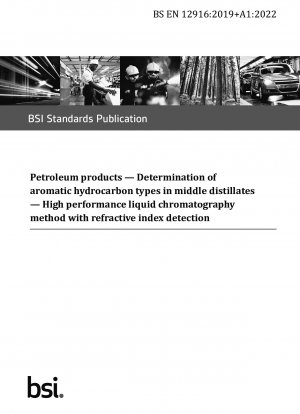BS EN 12916:2019+A1:2022
Petroleum products — Determination of aromatic hydrocarbon types in middle distillates — High performance liquid chromatography method with refractive index detection
- Standard No.
- BS EN 12916:2019+A1:2022
- Release Date
- 1970
- Published By
- British Standards Institution (BSI)
- Status
- 2024-03
- Replace By
- BS EN 12916:2024
- Latest
- BS EN 12916:2024
- Scope
- This document specifies a test method for the determination of the content of mono-aromatic, diaromatic and tri+-aromatic hydrocarbons in diesel fuels, paraffinic diesel fuels and petroleum distillates. This document defines two procedures, A and B. Procedure A is applicable to diesel fuels that may contain fatty acid methyl esters (FAME) up to 30 % (V/V) (as in [1], [2] or [3]) and petroleum distillates in the boiling range from 150 °C to 400 °C (as in [4]. Procedure B is applicable to paraffinic diesel fuels with up to 7 % (V/V) FAME. This procedure does not contain a dilution of the sample in order to determine the low levels of aromatic components in these fuels. The polycyclic aromatic hydrocarbons content is calculated from the sum of di-aromatic and tri+aromatic hydrocarbons and the total content of aromatic compounds is calculated from the sum of the individual aromatic hydrocarbon types. !The measurement ranges that apply to this method are given in Table 2 and 3." Compounds containing sulfur, nitrogen and oxygen can interfere in the determination; mono-alkenes do not interfere, but conjugated di-alkenes and poly-alkenes, if present, can do so. For the purpose of this European Standard, the terms “% (m/m)” and “% (V/V)” are used to represent the mass fraction, µ, and the volume fraction, φ, of a material respectively. By convention, the aromatic hydrocarbon types are defined on the basis of their elution characteristics from the specified liquid chromatography column relative to model aromatic compounds. Their quantification is performed using an external calibration with a single aromatic compound for each of them, which may or may not be representative of the aromatics present in the sample. Alternative techniques and test methods may classify and quantify individual aromatic hydrocarbon types differently. Backflush is part of laboratory-internal maintenance. standard does not purport to address all of the safety problems associated with its use. It is the responsibility of users of this standard to take appropriate measures to ensure the safety and health of personnel prior to application of the standard, and fulfil statutory and regulatory requirements for this purpose.
BS EN 12916:2019+A1:2022 history
- 2024 BS EN 12916:2024 Petroleum products. Determination of aromatic hydrocarbon types in middle distillates. High performance liquid chromatography method with refractive index detection
- 1970 BS EN 12916:2019+A1:2022 Petroleum products — Determination of aromatic hydrocarbon types in middle distillates — High performance liquid chromatography method with refractive index detection
- 2019 BS EN 12916:2019 Petroleum products. Determination of aromatic hydrocarbon types in middle distillates. High performance liquid chromatography method with refractive index detection
- 2016 BS EN 12916:2016 Petroleum products. Determination of aromatic hydrocarbon types in middle distillates. High performance liquid chromatography method with refractive index detection
- 2006 BS EN 12916:2006 Petroleum products - Determination of aromatic hydrocarbon types in middle distillates - High performance liquid chromatography method with refractive index detection
